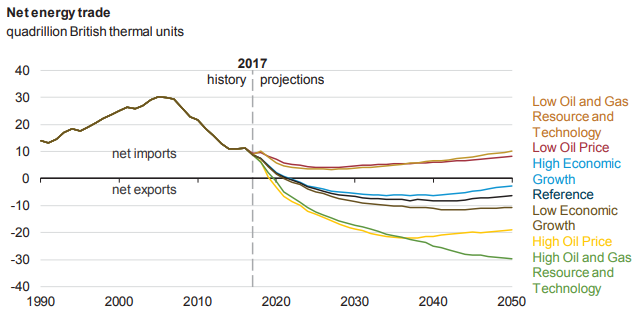The United States has been a net energy importer since 1953, but new projections from the Energy Information Administration (EIA) indicate that will soon change. On the heels of the news that the country became a net natural gas exporter last year for the first time in six decades, continued robust domestic energy productions could enable the United States to be a net energy exporter by 2022.
In the announcement for this year’s Annual Energy Outlook, EIA Administrator Capuano acknowledged that the U.S. energy sector’s ongoing transformation has led to a “very different set of expectations than we imagined even five or ten years ago.”
A stronger, more productive energy sector is undoubtedly a positive development. It can help fuel higher economic growth, and attenuate energy-related national security concerns. America’s policy framework should take care to avoid imposing policies that would impede the thriving sector, particularly in complementary areas, including energy transportation infrastructure such as pipelines and liquefied natural gas terminals. Corresponding improvements and development of this infrastructure are vital in getting the energy production to where it needs to go, whether it is for domestic use or to global markets for export.
The EIA report includes a range of different projections based on different assumptions about energy prices, technological improvements, and other variables. The reference case only includes existing laws and policies, and assumes that current economic, demographic, and technological trends reflect the current views of forecasters. The EIA states that the reference case should not be interpreted as its pick for the most probable scenario. But since the reference case projection tends to fall in the middle of the range of different scenarios, it is useful as an indicator and it is the main scenario referenced in this article.
While the date is still only a projection, and obviously subject to change, it is striking how rapidly the projected date of the country’s net energy exporter status has moved closer in iterations of the report. In 2010, the United States was projected to still be a net energy importer throughout the projected 25-year range, to the tune of 30.2 quadrillion Btu per year in 2035.
In the 2015 report, the country was projected to finally become a net energy exporter by 2029. In last year’s report the United States was projected to become a net energy exporter by 2026. In the latest 2018 report, the country is projected to reach that milestone by 2022, and net energy exports in 2035 would exceed 7.7 quadrillion Btu.

Source: U.S. Energy Information Administration, “Annual Energy Outlook 2018.”
In all but the two most pessimistic scenarios, the country will become a net energy exporter. In the more optimistic projections with higher oil prices and more rapid technological developments, the United States would become a net exporter even sooner than 2022.
The major factors behind the new projections have to do with natural gas production, which accounts for almost 40 percent of domestic energy production by 2050. The report specifically mentions the “continued development of the Marcellus and Utica” shales as the main driver of growth in shale production.
While natural gas plays the primary role, crude oil projections is also now projected to increase significantly, at least in the medium-term. In the reference case, production in 2018 is set to eclipse the 9.6 million barrels per day record set in 1970, and will continue to grow until eventually plateauing around 11.7 million barrels per day.
These two factors, along with more production of renewables, result in total U.S. energy production increasing by 31 percent by 2050.
As mentioned, these are only projections, albeit credible ones from a respected government agency. Government policy is one area that will affect the trajectory of domestic energy production and how long the country will remain a net energy importer. Blanket antagonism to energy production or infrastructure proposals could severely limit any potential benefits that would otherwise accrue from a booming energy sector.
For example, a cargo load of liquefied natural gas from Russia arrived in Boston at the end of January. These constraints in the natural gas pipeline capacity, themselves the result of antipathy from states in the region, caused natural gas prices to spike during a recent cold spell. Policies hindering the domestic energy sector are increasing the role of energy imports. Some Massachusetts liberals were no doubt glad to use Russian rather than American oil.
The surge in domestic energy production has changed the landscape of energy around the world, and could allow the United States to become a net energy exporter by 2022. While some developments have been encouraging, in other areas and regions the energy sector’s policy and regulatory framework has not evolved in kind. In order for the country to tap into the full potential of its energy sector. Federal and state governments should foster investment and development. Allowing well-vetted energy infrastructure projects to be constructed and put into service will help domestic markets and enable U.S. energy exports to thrive.
Charles Hughes is a policy analyst at the Manhattan Institute. Follow him on Twitter @CharlesHHughes.
Interested in real economic insights? Want to stay ahead of the competition? Each weekday morning, E21 delivers a short email that includes E21 exclusive commentaries and the latest market news and updates from Washington. Sign up for the E21 Morning Ebrief.
